August 23 - 29, 2015: Issue 228
Old Chinese Rice Bowls for Marriage: Worth More Than You Think...
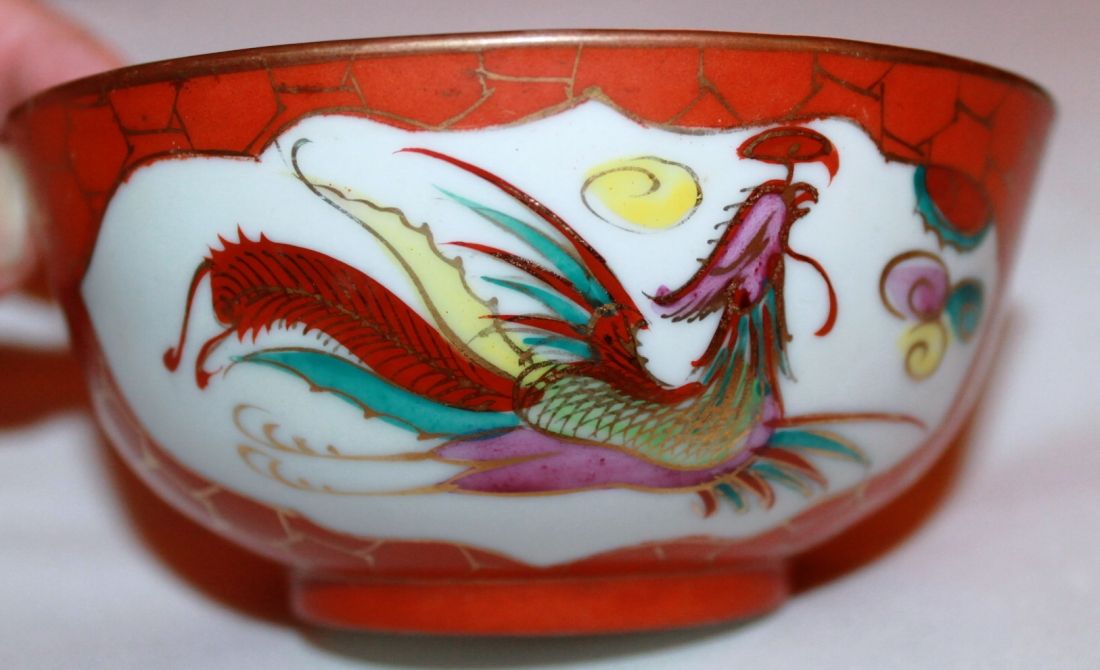
Old Chinese Rice Bowls for Marriage: Worth More Than You Think…
Hold on to those lovely old Chinese rice bowls and porcelain. Some of those we have recently been given are worth affair bit more than you may think and the more unusual or rare ones will fetch a lot lot more – should you wish to part with them. In March 2013 a 1,000-year-old Chinese bowl bought for a few dollars at a garage sale in New York state sold for more than $2.2 million at a Sotheby’s auction. Said to be a "Ding" bowl, which is from the Northern Song Dynasty, and measures just over five inches (12.7 cm) in diameter, for which no more than $3 was paid in 2007 and displayed it on a mantelpiece with no idea as to its real worth, Sotheby's said.
The only known bowl of the same form, size and almost identical decoration has been in the collection of the British Museum in London for more than 60 years.
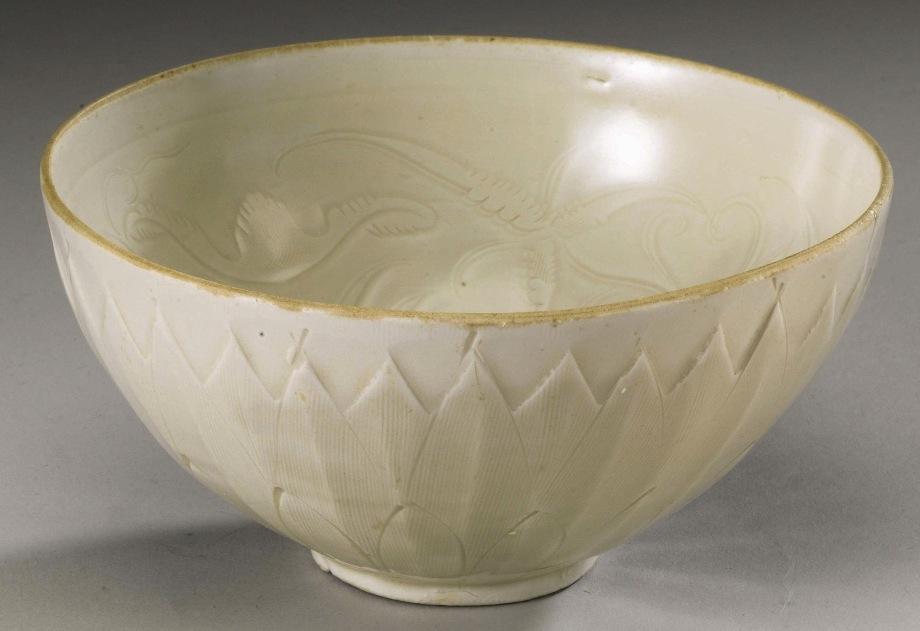
The 'Ding' Bowl Northern Song Dynasty - bopugt for $3 - sold for $2 million
Then in April 2013 another rice bowl fetched $9 million – setting the world record for Qing ceramics from the Emperor Kangxi era, as wealthy Chinese collectors are showing interest for Chinese antiques and fine works of art. The Falangcai 'Double-Lotus' bowl is from the 1662 to 1722 era. It's the only bowl recorded with this design and it typifies one of the earliest pieces decorated in the newly introduced Western enameling technique.
It has a stunning ‘raspberry’ colour and a pattern of a continuous lotus pond landscape—lotus blooms in yellow, blue, pink, and white hues—with single and double flower heads on delicate stems.
"It's a very special bowl, very exclusive. The last two, three pieces that have appeared in the last 10 years were not in perfect condition. This is in absolute mint condition, which is very unusual for this type. And the decoration is particularly pleasing. It's got the design, as you can see, of the double lotuses. Not single lotuses, double lotuses, which is the sign of a very auspicious reign for an emperor." Nicholas Chow, Sotheby's Asia Deputy Chairman stated.
Traditional Chinese rice bowls measure 4 ½ inches or close to 12 centimetres around their rims.
In Japanese culture the rice bowl was, anciently, designed to fit perfectly in the user’s hand. The 12 centimeter diameter of a rice bowl is derived from the average diameter of a Japanese person’s hand when a half-circle is made with the thumb and pointing finger. In other words, it is the perfect size that naturally fits in the hands of the user. The height is set at half the diameter, which is 6 centimeters. The ratio between the pointing finger and thumb is said to be exactly 2:1, and this ratio does not change in any configuration of the hand. Some state that this ratio creates the ideal relationship between the hand and the rice bowl.
In ancient times, the “Wan” bowl used to be called “Mari” (old Japanese term for ‘ball’). The name is said to derive from the spherical shape of the bowl being denotative of a ball. Aside from the variations with differing shapes, the ‘ideal bowl’ is said to be one that creates a 4-sun (12 centimeter) sphere when two bowls are cupped together. This 12-centimeter (4-sun) diameter is the common standard even amongst the multiple regions across Japan.
The measurement units such as “sun” that are embedded in the ancient history of Japan derive from measurements and proportions of the human body, collectively known as “Shindoshaku”.
With so much interchange of knowledge and culture between Japan and China from earliest times, and with ancient China leading the world for centuries in health and body functions and proportions, it seems likely this too is a transference of ancient knowledge that may indicate why rice bowls are the size they are.
Rice itself was one of the earliest crops planted in Australia by British settlers, many of whom had experience with rice plantations in the Americas and India. In the 1920s it was seen as a possible irrigation crop on soils within the Murray-Darling Basin that were too heavy for the cultivation of fruit and too infertile for wheat. Californian varieties of rice were found suitable for the climate in the Riverina, and the first mill opened at Leeton in 1951. Australia has, on occasion, produced more rice than anywhere else in the world:
Rice.
The following are a few well-known articles of food which have been experimented with in order to find out how far they are assimilated into tits'*human system, and the figures are worthy of special attention. Taking 100 parts of each article, the percentages assimilated are: Meat ... „ 96-7 I Maize... ... Rice ,M „, 86*1 I Potatoes Eggs ... ?.„ 94-8 .1 Milk .„ Wheaten bread... 84-4- 1 Rye Bread
Rice next to meat, therefore, imposes less work on the digestive organs, and gives more satisfactory results than any other vegetable. It is far in advance of potatoes, which are now more largely used than any other vegetable in Great Britain, and it has the advantage that it is always obtainable, and will keep good for an indefinite period. In order, however, that the fullest advantage should be obtained from the use of rice it is essential that it should be properly prepared and cooked. Rub the rice vigorously between the hands in cold and frequently… water until the water remains quite Place it then with plenty of water on a brisk fire and leave it to boil for about 15 minutes. The grains must be soft, but should not 8pfifc.';gThis done, pour it into a strainer and run cold water over it until the water comes out quite clear and place it on the hot store-top as is done with boiled potatoes, shaking it about occasionally in order to aid in the process of drying. Rice. (1892, October 4). Evening News (Sydney, NSW : 1869 - 1931), p. 3. Retrieved from http://nla.gov.au/nla.news-article113313126
Australia's "Rice Bowl."
A remarkable record has just been achieved by the NSW Water Conservation and Irrigation Commission in the preparation, ditching, ploughing, sowing and irrigating of 5,000acres of rice land in a matter of six months, wrote the "Land," Sydney, on October 29.
Mr W. Rawlings, the Rice Commissioner, said this week that work began on the area in April, and a definite schedule was laid down to be completed by July 29. The big team of men engaged on the job actually completed the schedule by July 28.
"We started sowing the 5,000 acres on September 20," said Mr Rawlings," and completed that part of the job on October 7, the exact date fixed six months previously. The highest record for one day's sowing was 403 acres-a remarkable performance,
This, probably the world's largest .rice farm, was put under crop at the request of the Commonwealth authorities to meet the huge demand for rice from the islands and the civil population-at home.
Last week it was officially announced by the Commonwealth Minister for Commerce and Agriculture, that a further quota was to be sown at Wakool next season. This, it is stated, refers to an additional 5,000 acres, which will make 10,000 acres in the Wakool rice belt. Australia's "Rice Bowl.". (1943, November 25). Western Mail(Perth, WA : 1885 - 1954), p. 40. Retrieved from http://nla.gov.au/nla.news-article38552928
Australian Rice Bowl Criticised
Six million movie-going Australians had been fed on a screen diet of glamorous success stories from America and Europe but had never seen one of their own nation's greatest developments.
This comment was made by Major General Sir Kingsley Norris on the conclusion of a visit to Murrumbidgee Irrigation Areas. Sir Kingsley recently, returned from a special mission overseas associated with the recruitment of scientific personnel and during an intensive three-day inspection of the irrigation areas met many overseas scientists. 'Enterprise, initiative and confidence in the future displayed by M.I.A. people regarding their industries, their area and their ability to grow is an example to Australia'-' Sir Kingsley declared. 'It is surely time that the people and the industries concerned got together to ensure that this success story is told everywhere in Australia. A film for distribution at home and abroad is a prime need if people are to know what has been achieved.
'I don't know why it has not been done before but I strongly recommend this project be followed up now,' Sir Kingsley added.
Industrial development Committees of the main M.I.A. towns and shires are meeting to discuss a technicolor cinerama film on the irrigation areas which may be released by Columbia Pictures Corporation of U.SA. Mr. C. E. Balton, Manager of Rice Marketing Board said 'There is no doubt if our project had been located in another country the world would have heard a lot more about' it. 'We are still getting visitors to the 'Rice Bowl' area 'who believe that Australia imports all its rice from Asia.' 'It would probably be true to say that not one Australian in 20 would know that their country had the highest rice yields in the world and held three world records in rice production.'Australian Rice Bowl Criticised. (1963, February 22). Western Herald (Bourke, NSW : 1887 - 1970), p. 7. Retrieved fromhttp://nla.gov.au/nla.news-article142314050
Rice bowl festival
March and April are the months when the harvesting of the rice crop begins in the Riverina, N.S.W. And there are festivities to mark this event. THE town of Leeton, N.S.W., was the centre of the festivities in celebration of this year's annual Rice Bowl Festival. It's a busy, happy time with street parades and processions; included as part of the festivities was a rice cookery contest. Rice bowl festival. (1970, May 6).The Australian Women's Weekly (1933 - 1982), p. 132 Supplement: Rice Cook Book. Retrieved from http://nla.gov.au/nla.news-article51275661
Leeton still has a Rice Festival, held every second Easter, the next being March 24-28, 2016. You can find out more about that HERE -Facebook page
A ‘Rice Bowl’ Area is a term used to define a place where rice grows plentifully.
There is a Chinese proverb that goes, "without rice, even the cleverest housewife cannot cook." Rice is synonymous with China-rice cultivation goes back at least three to four thousand years. It is part of China's culture, history and heritage, much like potatoes are to Ireland. The word for rice in Chinese is the same as the word for food.
"Iron rice bowl" (simplified Chinese: traditional Chinese: pinyin: tiě fàn wǎn) is a Chinese term used to refer to an occupation with guaranteed job security, as well as steady income and benefits. The Chinese term can be compared to the similar (but not identical) English concept of a "job for life". Traditionally, people considered to have iron rice bowls include military personnel, members of the civil service, as well as employees of various state run enterprises (through the mechanism of the work unit).
Because the "Iron Rice Bowl" guaranteed a stable standard of living regardless of the amount of effort made by the worker, the term is also used to describe extremely unmotivated and unproductive workers.
Rice is the seed of the grass species Oryza sativa (Asian rice) or Oryza glaberrima (African rice). As a cereal grain, it is the most widely consumed staple food for a large part of the world's human population
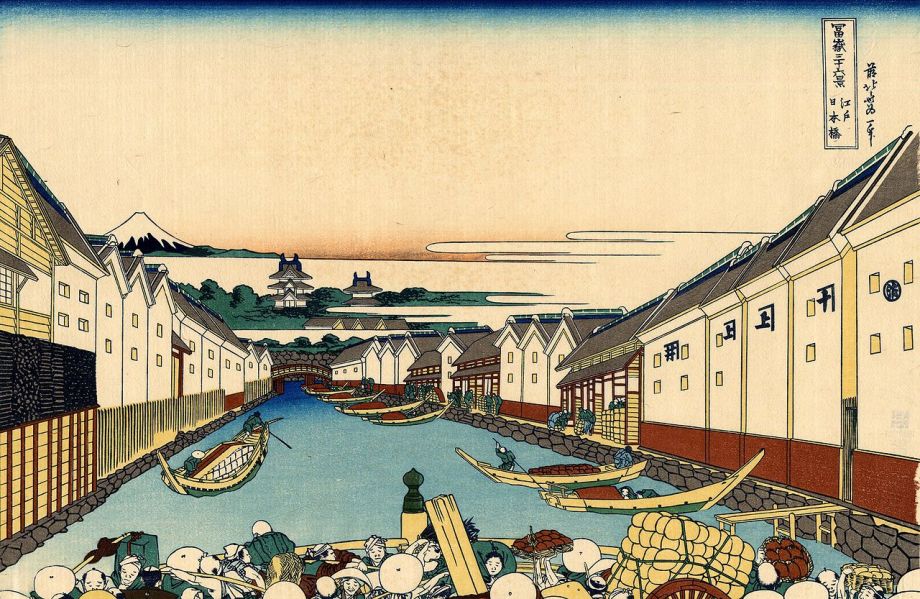
Rice broker in 1820's Japan of the Edo period ("36 Views of Mount Fuji"Hokusai) - Nihonbashi_bridge_in_Edo
There have been plenty of debates on the origins of the domesticated rice. Genetic evidence published in the Proceedings of the National Academy of Sciences of the United States of America (PNAS) shows that all forms of Asian rice, both indica andjaponica, spring from a single domestication that occurred 8,200–13,500 years ago in China of the wild rice Oryza rufipogon. A 2012 study published in Nature, through a map of rice genome variation, indicated that the domestication of rice occurred in the Pearl River valley region of China based on the genetic evidence. From East Asia, rice was spread to South and Southeast Asia. Before this research, the commonly accepted view, based on archaeological evidence, is that rice was first domesticated in the region of the Yangtze River valley in China.
Morphological studies of rice phytoliths from the Diaotonghuan archaeological site clearly show the transition from the collection of wild rice to the cultivation of domesticated rice. The large number of wild rice phytoliths at the Diaotonghuan level dating from 12,000–11,000 BP indicates that wild rice collection was part of the local means of subsistence. Changes in the morphology of Diaotonghuan phytoliths dating from 10,000–8,000 BP show that rice had by this time been domesticated. Soon afterwards the two major varieties of indica and japonica rice were being grown in Central China. In the late 3rd millennium BC, there was a rapid expansion of rice cultivation into mainland Southeast Asia and westwards across India and Nepal. (2)
Chinese Porcelain
Porcelain can informally be referred to as china or fine china, as China was the birthplace of porcelain making.
Although proto-porcelain wares exist dating from the Shang Dynasty (1600–1046 BC), by the time of the Eastern Han Dynasty period (206 BC – 220 AD), glazed ceramic wares had developed into porcelain. Porcelain manufactured during the Tang Dynasty (618–907 AD) was exported to the Islamic world, where it was highly prized. Early porcelain of this type includes the tri-colour glazed porcelain, or sancai wares. There is no precise date to separate the production of proto-porcelain from that of porcelain. Porcelain items in the sense that we know them today could be found in the Tang Dynasty, and archaeological finds have pushed the dates back to as early as the Han Dynasty (206 BC – 220 AD). By the Sui Dynasty (581–618 AD) and Tang Dynasty (618–907 AD), porcelain was widely produced.
Eventually, porcelain and the expertise required to create it began to spread into other areas of East Asia. During the Song Dynasty(960–1279 AD), artistry and production had reached new heights. The manufacture of porcelain became highly organised, and the kiln sites excavated from this period could fire as many as 25,000 wares. While Xing Ware is regarded as among the greatest of the Tang Dynasty porcelain, Ding Ware, such as the bowl sold in 2013, became the premier porcelain of Song Dynasty. By the time of the Ming Dynasty (1368–1644 AD), porcelain wares were being exported to Europe. Some of the most well-known Chinese porcelain art styles arrived in Europe during this era, such as the coveted blue-and-white wares. The Ming Dynasty controlled much of the porcelain trade, which was expanded to Asia, Africa and Europe via the Silk Road. In 1517, Portuguese merchants began direct trade by sea with the Ming Dynasty, and in 1598, Dutch merchants followed. (1)
Bowls, such as those shown in the photographs here, with dragons, phoenixes, gourds, and characters, are for happiness. This one has brought much happiness to our family as it can be traced to a certain engagement, on a certain evening dinner, and bought from the owner of that restaurant on that evening - so we can state emphatically it is at least 55 years old.
With Chinese porcelain, as with all porcelain, the way to determine who may have made it and where and when it was made is to look at the base and the makers marks. The numbers shown here refer to a factory and indicate one of these was made mid 1950's and the others, with the wider gold brim, were made during the 1960's in the vicinity of Jingdezhen and are Jingdezhen ware.
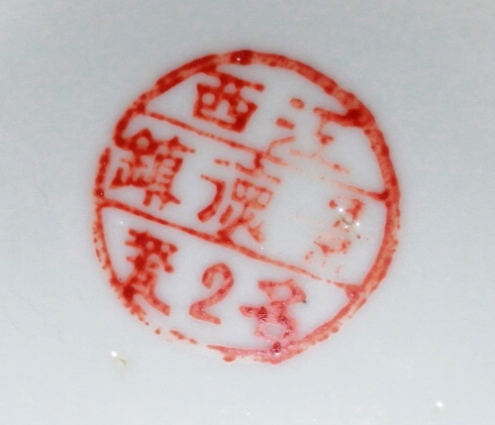
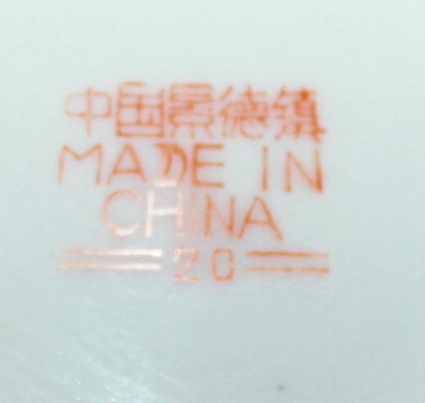
Jingdezhen ware refers to ceramics, particularly porcelain, produced in the vicinity of Jingdezhen, China. Jingdezhen is believed to have produced pottery as early as the sixth century CE. According to the Chinese historical records, Jingdezhen has a history of making porcelain for 2000 years since Han Dynasty.
Jingdezhen is known as the “town of porcelain” and is not merely famous for its porcelain making; the more important is the porcelain it produced enjoys great prestige in the whole world.
Jingdezhen is located in the northeast of Jingxi province and supervised by Fuliang in history. In East Jin Dynasty, it was called Xinping town. Then its name was changed into Changnan (also known as Taoyang) in Tang Dynasty. The name, Jingdezhen, started in Jing De period of Song Dynasty. During the Han Dynasty, on the base of workmanship of Shang and Zhou Dynasty, people in Jingdezhen made “blue pottery with glaze”. During the Jin Dynasty, a craftsman named ZhaoKai made great contribution to the progress of porcelain quality in Jingdezhen region, so he was called the “the master of porcelain making”. With the development of times, prosperity of the economy in east China, and the improvements in the technique of making porcelain, Jingdezhen porcelain was sold all parts of China. In AD 583, the emperor of Nan Dynasty, Chen Shubao ordered a porcelain pillar for the villa in Jingdezhen. Before long, the emperor, Yang of Sui Dynasty asked for lion and elephant ceramics for the palace. (4)
In around 1953 to 54, almost all the factories in Jiangxi were merged into larger units, each made up by ten to fifteen previously independent factories. From this time factory numbers such as =9= came to be used. The use of alphabetic characters and numbers in the marks also seems to have started around this time. Long time porcelain merchant in Hong Kong, Mr. Kung, was when asked by Simon Ng on this, of the opinion that =09= and similar, were names assigned to each of the factories in Jingdezhen by the Communist Party.
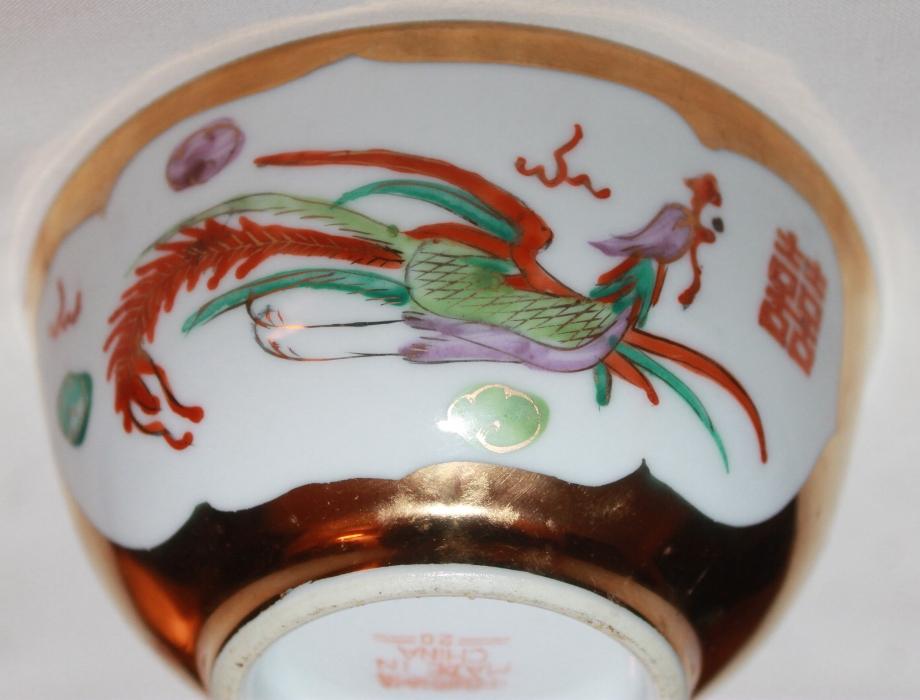
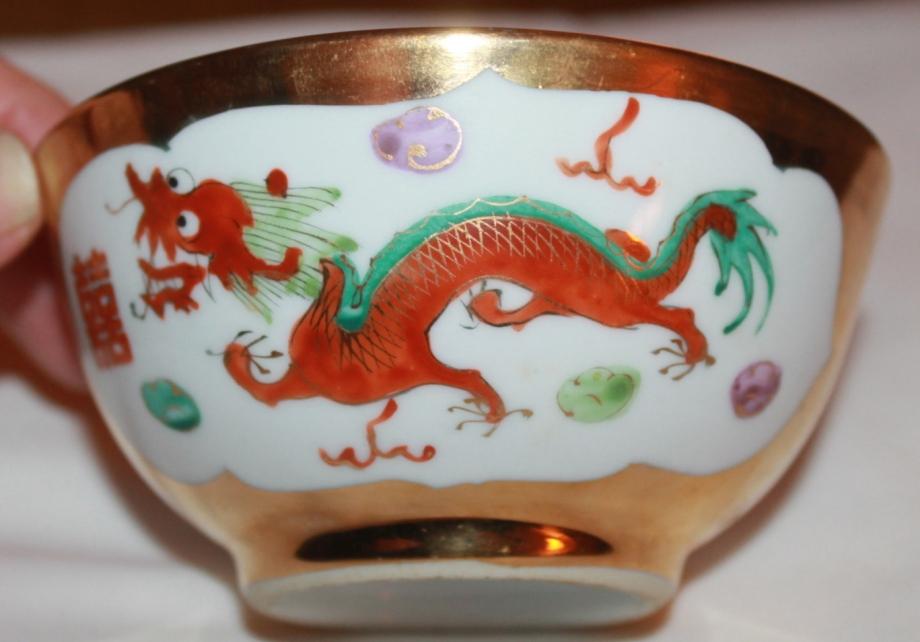
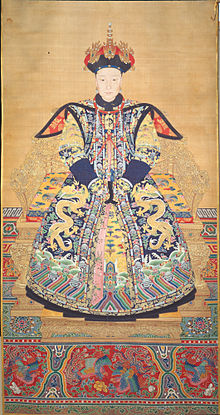 From the period of the Jiajing Emperor (1522–66) on, a pair of phoenixes was differentiated by the tail feathers of the two birds, typically together forming a closed circle pattern—the male identified by five long serrated tail feathers or "filaments" (five being an odd, masculine, or yang number) and the female by what sometimes appears to be one but is in fact usually two curling or tendrilled tail feathers (two being an even, feminine, or yin number). It was during this period, the fenghuang was used as a symbol representing the direction south. This was portrayed through a male and female facing each other. Their feathers were of the five fundamental colors: black, white, red, green, and yellow. These colors are said to represent Confucius' five virtues:
From the period of the Jiajing Emperor (1522–66) on, a pair of phoenixes was differentiated by the tail feathers of the two birds, typically together forming a closed circle pattern—the male identified by five long serrated tail feathers or "filaments" (five being an odd, masculine, or yang number) and the female by what sometimes appears to be one but is in fact usually two curling or tendrilled tail feathers (two being an even, feminine, or yin number). It was during this period, the fenghuang was used as a symbol representing the direction south. This was portrayed through a male and female facing each other. Their feathers were of the five fundamental colors: black, white, red, green, and yellow. These colors are said to represent Confucius' five virtues: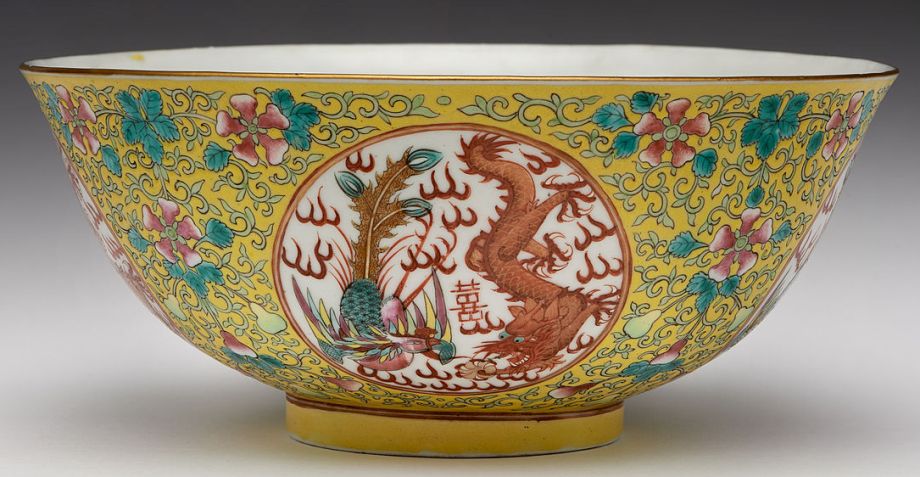
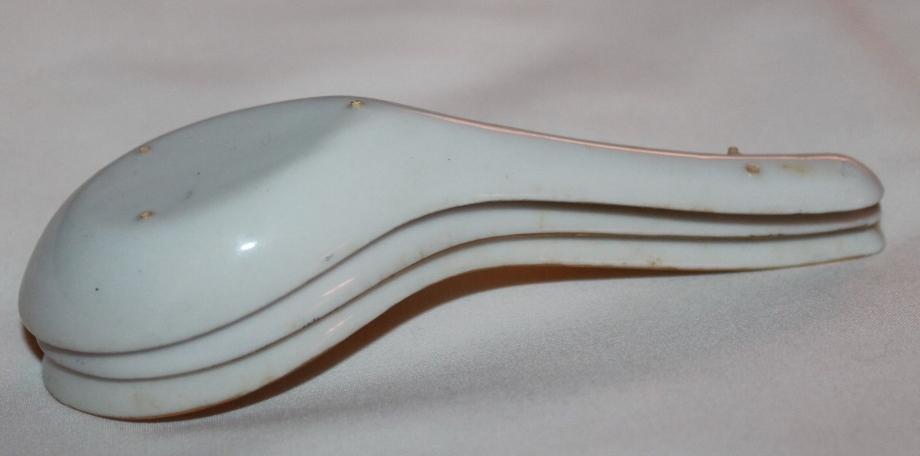
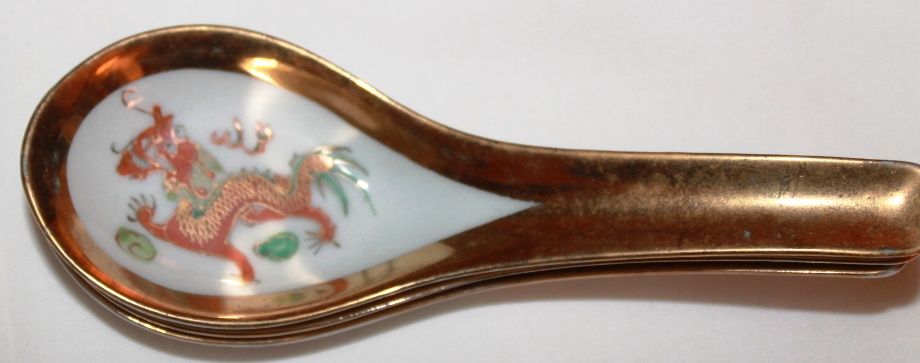
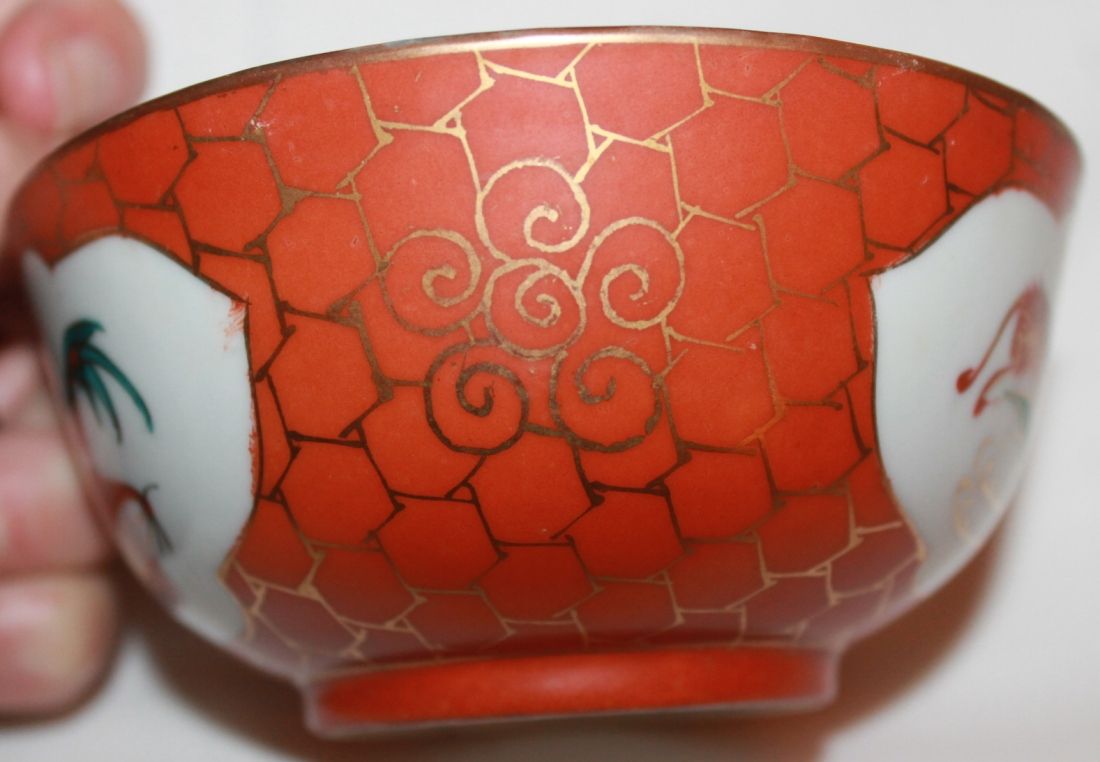
The first bowl of Happiness
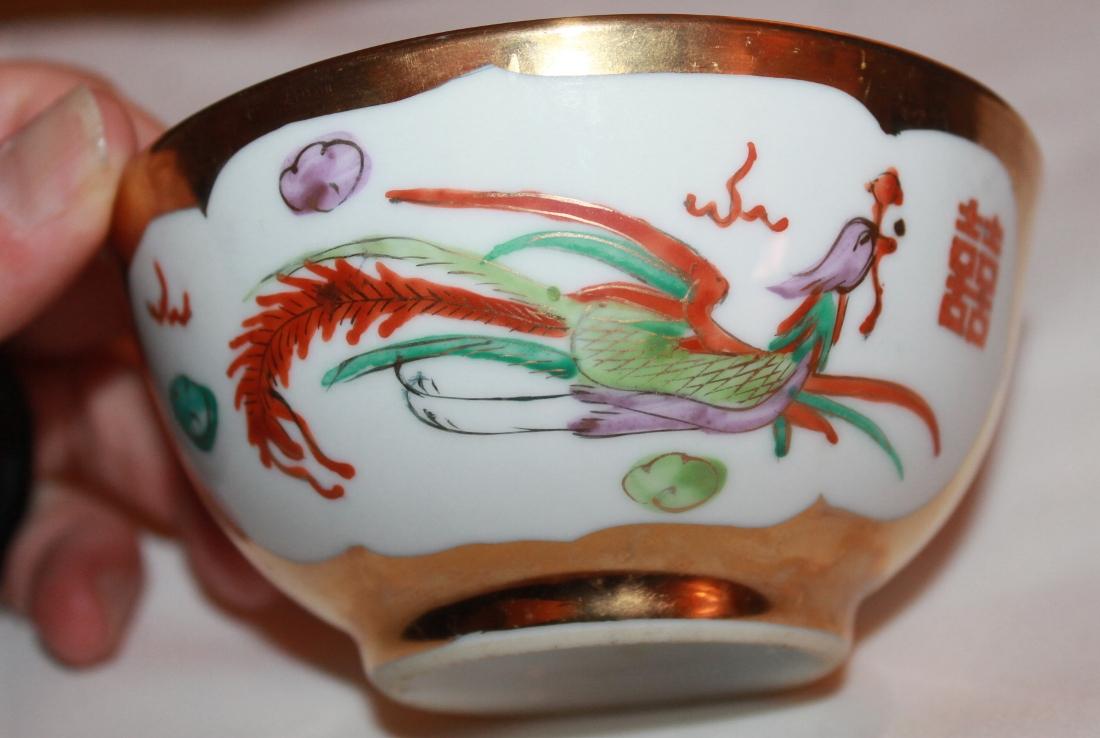
Those found to match and double then double then Double the Happiness again.
Previous Collectors Corner pages:
Blacksmiths and Tinsmiths Nylon Stockings Poster Art Furphy's Water Cart Mousehole Anvil Sapphire One Armed Bandit Gould's 1840 Single and Compound Microscope Tibetan Thangka Wheel Of Life Painting Cast Iron Seats Mabel Lucie Atwell Prints The Customs of Traditional Dining by Hans and Jenny Carlborg Albert Collins Landscape Boomerang Harmonicas Drinking: 18th Century Style Part I by H&J Carlborg Drinking 18th Century Style Part II by H&J Carlborg Fleece Shears Wood Case Crank Telephone 1803 Timepeice Vintage Guitars Milestones No.38RollsRoyceMotorOiler Christmas Postcards Seashells McCormick-Deering Horse Drawn Mower Rope Making Machine Marilyn Monroe 1955 Calendar Stubbie Holders Hill's Hoist Akubra Hat Fowler's Bottling Kit The Bold Autographed Script Fishing Tackle Arnotts Biscuit Tins Comic Books Silver Opium Pipe Mrs Beetons Book Souvenir Teaspoons Bendigo Pottery Gianelli Figurines Key Fobs Model Aircraft-static Porcelain Slippers Wagon Wheels Rhys Williams Painting Chinese Guardian Lions Australian Halfpenny Bud Vases Rolling Stones Still Life LP Autographed WL1895 Thinking Monkey Estee Lauder Ginger Jar Reel Mowers Surf Reels Millers Car Collection Hilton Lingerie - Slips Miniature Books of Verse - A Romantic Tradition REGA Pouring Can R O Dunlop - Sailing At Itchenor Painting Morning Shadows by C Dudley Wood The Father of Santa Claus - Xmas 2012 HMS Penguin Anchor at RPAYC - Newport SS Birubi Mast at RMYC - Broken Bay Helen B Stirling Ship's Wheel at Club Palm Beach Woomeras HMSEndeavour Replica Cannon at RPAYC The Doug Crane Classic Handmade Double Blade Paddle HMS BountyWooden Ship Model Collecting Ladies - Ferdinand Von Mueller and Women Botanical Artists Australian Bark Art Chinese Ginger Jars Hand Plough and Jump Stump Plough - Australian Inventions Frank Clune Books Frederick Metters - Stoves, Windmills, Iron Monger Trinket Boxes 1933 Wormald Simplex Fire Extinguisher is Pure Brass Chapman 'Pup' Maine Engines - Chapman and Sherack The Beach Ball Figureheads Salty Wooden Personifications of Vessels Binnacle at RMYC The Australian Florin - Worth More Than 20 Cents to Collectors Weathervanes; For Those Passionate About Seeing Which Way the Wind Blows Her Majesty's Theatre 1962 Programme - Luisillo and his Spanish Dance Theatre Cooper's Sheep Shower Enamel Sign and Simpso's and Sons of Adelaide Jolly Drover Sugar Bowl and English Pottery A Means to Gaze into the Past Chief Joseph and Edward S Curtis; His Remarkable Images of Native Americans an Inestimable Record of Images and Portrait Photographs His Masters Voice, Old 78'Âs and Australia's Love of Music Jack Spurlings 'Tamar' Picture 1923 Resch's Beer Art - A Reflection of Australiana Now Worth Thousands The Compleat Angler - Izaak Walton's Discourse Inspires Generations of Fishers Portable Ice-Boxes and Coolers  How Many Claim This Invention as Theirs? Malley's and Sons Ltd. - A Munificent Australian Family Company Vintage Paddles and Gigs Nautical Memorabilia The Crinoline - a 550 Year Old Fashion B.B. King - King of the Blues Goes Home: a Timely look into Photographs and Autographs and Being Buyer Aware Deep Down Among the Coral - By Christopher Corr - A Limited Edition Print in Celebration of the seventy fifth anniversary of QANTAS Airways
Old Chinese Rice Bowls for Marriage: Worth More Than You Think… - article by A J Guesdon, 2015.